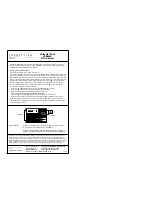
Web: www.tinker-rasor.com
E-mail: [email protected]
– 3 –
P
RODUCT
I
NSTRUCTIONS
1. Attach handle to RECEIVER and TRANSMITTER as shown on page 2.
2. Pull RECEIVER power switch to “ON” for loudspeaker operation. If headphones are desired,
simply plug in headphones and RECEIVER will be turned on automatically.
3. Turn RECEIVER sensitivity control knob to the “STAR”. Set gain switch to “L”.
4. Pull TRANSMITTER power switch to “ON”. Set CONDUCTIVE-INDUCTIVE switch to
“INDUCTIVE”.
5. To tune, hold instrument at proper operating height (pg. 2) with the handle parallel to surface
being investigated. CAUTION: Tuning operation must be conducted over an area free from all
metallic objects, i.e. vehicles, wire fences, etc., otherwise improper tuning will result.
6. Rotate knob “T” to the right (CLOCKWISE) until spring starts to tighten. At this point, a full
scale meter reading and loud audible signal shall be noted. Now rotate knob “T” left (COUNTER-
CLOCKWISE) until meter reads zero and audible signal disappears. Then continue rotating knob
“T” left (COUNTER-CLOCKWISE) until faint visual and audible signal is observed. The
instrument is now properly tuned and ready to operate. When instrument is passed over metallic
pipes, or other conductive objects, a sharp increase of audible and visual signal will result.
7. If unable to “tune” per above directions, reduce “SENSITIVITY” control slightly.
The pipe or cable under surveillance should be approached at an approximate right angle to the assumed
direction of its course. As the pipe or cable is approached and crossed, an increase in audio and visual
indications will be noted from the RECEIVER. The maximum indication shall be when the
TRANSMITTER is directly over the object. Once the pipe or cable is found, the SENSITIVITY control
can be readjusted to govern the amount of signal indication received. It will originally be noted that the
signal indication over a buried pipe is very wide. By reducing the setting of the SENSITIVITY control, the
width of indication can be narrowed and pipe location pinpointed. The effectiveness of your locator is
largely dependent on proper usage of the SENSITIVITY control. If SENSITIVITY is adjusted to narrow
one point of investigation-retune before proceeding with investigations at other points.
INDUCTIVE OPERATION (WITHOUT HANDLE)
Accurate tracing of concealed pipes, cables and conduits can best be accomplished by using the
RECEIVER and TRANSMITTER uncoupled.
In this method of operation, the RECEIVER and TRANSMITTER units are employed separately without
the connecting handle. This can be done as a one or two man operation.
When using TRANSMITTER and RECEIVER separately, the maximum energy is induced and detected,
respectively, in the pipe or cable when the orientation of the individual units is vertical and parallel over the
pipe to be located. See illustration (PAGE 5).
To get the maximum induced energy into the buried pipe or cable, the TRANSMITTER must be placed
directly over it in a vertical and parallel position. The proper method of determining TRANSMITTER
PLACEMENT over a buried pipe or cable is illustrated in (FIGURES 3 and 4).
Operation of the RECEIVER and TRANSMITTER inductively should not be conducted within 25 feet of
each other or air coupling of the units may exist. Air coupling refers to the transmittal of the radio
frequency energy through air without the presence of a buried conductor. It may be possible to shorten
these distances by reduction of the SENSITIVITY control. However, to eliminate false indication the
operator should use caution when operating the units in enclose proximity of one another.
1.
Pull TRANSMITTER power switch to “ON” position.
DIVISION OF TINKER & RASOR
2828 FM 758, NEW BRAUNFELS, TX 78130 TEL: (830) 253-5621
www.detectron.com



























